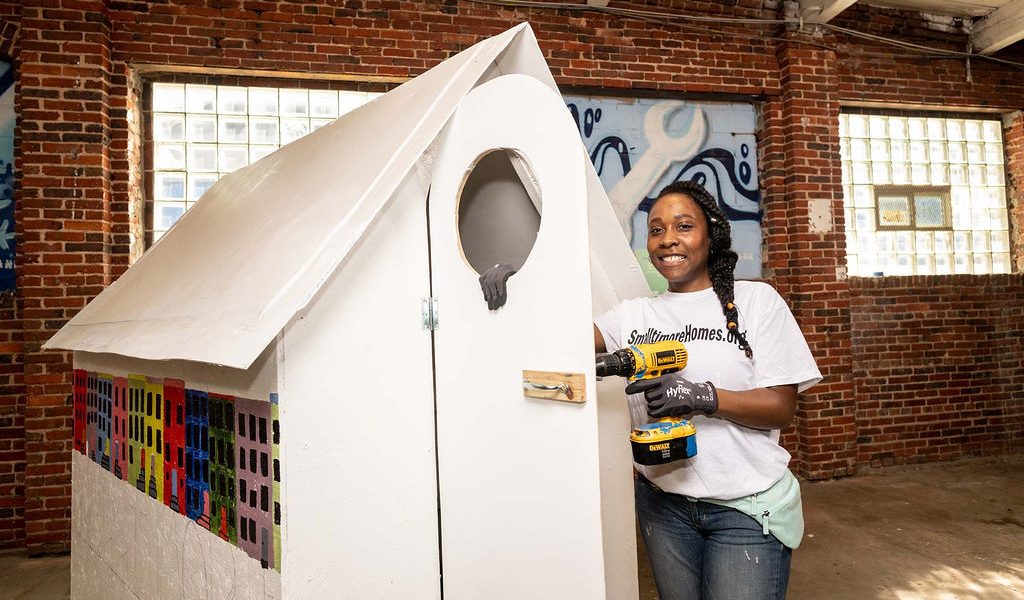Home & Living
Cameo: Quida Chancey
We talk to the founder of Smalltimore Homes.
What is Smalltimore Homes and how did it start?
I started investing in Baltimore real estate in 2014. I was fixing and flipping homes, and I was very intentional in selling to first-time homeowners, because, to be honest, I wanted those homeowners to look like me. Over time, it morphed from investing in the city and building up black homeowners to addressing people who are experiencing homelessness, which is something that impacts our community in a big way because two out of three people experiencing homelessness in Baltimore are black. So Smalltimore Homes was founded in February 2018 because I decided to start an affordable housing nonprofit and that would provide tiny homes outfitted with sleeping bags, clothes, and other supplies to people experiencing homelessness.
Why microshelters?
I think transitioning out of homelessness starts with having an address and a place to rest your head. Because how do you think about anything else if you don’t know where you’re going to sleep at night? I plan to partner with groups that provide things like job training and education to attack each piece of the issue so that someone can start by living in one of these microshelters, get the resources they need, and then work up to finding a room for rent and acclimate themselves back into life.
What kinds of challenges has Smalltimore Homes faced so far?
Because of their wheels and size, our first three microshelter models are not legal dwellings in Baltimore. But through volunteer builds, donations, and grants from the community, we’re able to continue improving the design and having conversations about how this will help homelessness in the city. Within the year, I’d like to create at least three microshelter communities with anywhere from two to five of the shelters for people to visit and experience. By the end of that year, I plan to acquire a piece of land to build the final, allowable model that people will be staying in.
How does Baltimore compare to other cities that have started micro-shelter communities?
We’re unique compared to other cities that have these kinds of shelters because we have blight and vacant buildings. I hope to partner with an organization that’s breaking down these vacant homes, take what’s salvageable, and use those materials to create new tiny dwellings.
What kind of feedback have you received from potential tenants?
One volunteer brought a homeless woman he knew to one of our monthly builds. I gave her some supplies and I asked her for her feedback on the homes. I asked her if she would sleep in one, and she said yes because, at the time, she was sleeping standing up in a corner of the Lyric every night. So I asked if she would stop if she had one of the microshelters as an option, and, if not, what would she change about it. All she suggested was bigger windows. And I was like, “I can do that! Someone give me a saw!”
What are your long-term goals for Smalltimore Homes?
In three to five years, I want to have a permanent plot of land with at least 15 tiny homes for people who were experiencing homelessness. I want it to be temporary housing for them, no more than three years, which will give them time to get back on their feet, save some money, and, hopefully, find a place of their own. On the plot of land, I’d love to implement a vertical garden that tenants can contribute to. If we could have a whole city block with no blight and full of microshelters and sustainable living for people experiencing homelessness, that would be bliss.
Why do you think this idea will work?
I think it’ll work in Baltimore as long as we can address blight as part of this initiative. A lot of people have said, “How can you start something like this when there’s so many abandoned buildings in the city?” But people can’t move into those places. That’s the thing that I recognize is unique about doing this project in Baltimore—we can address both issues at the same time. Overall, I think if we can contribute to this growing ecosystem of people and programs working to help people transition into society then this city will be a much better place.
